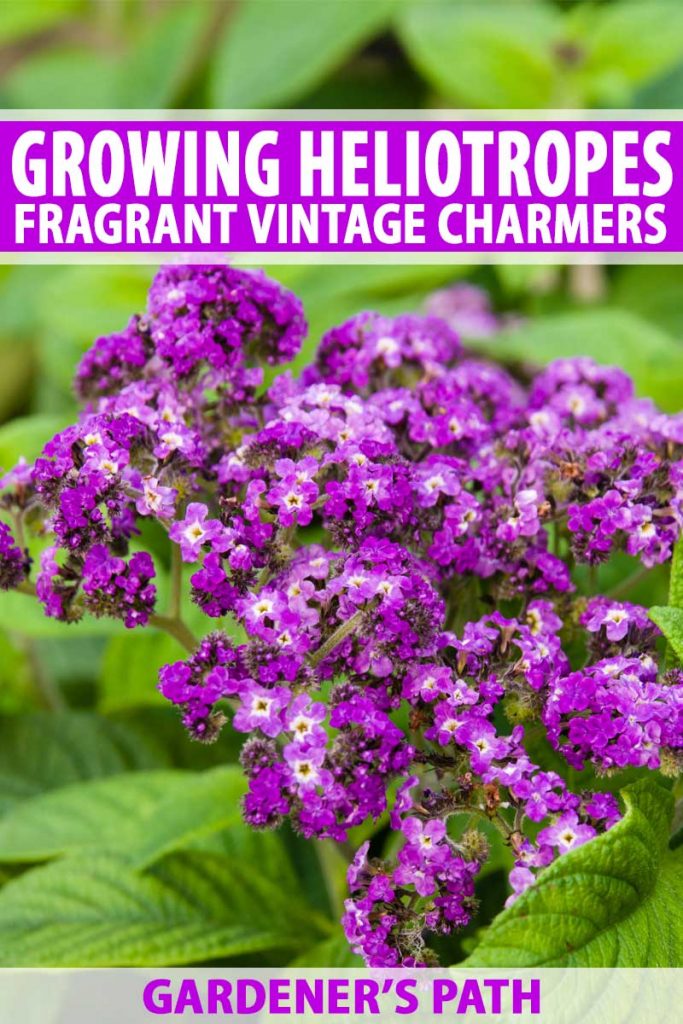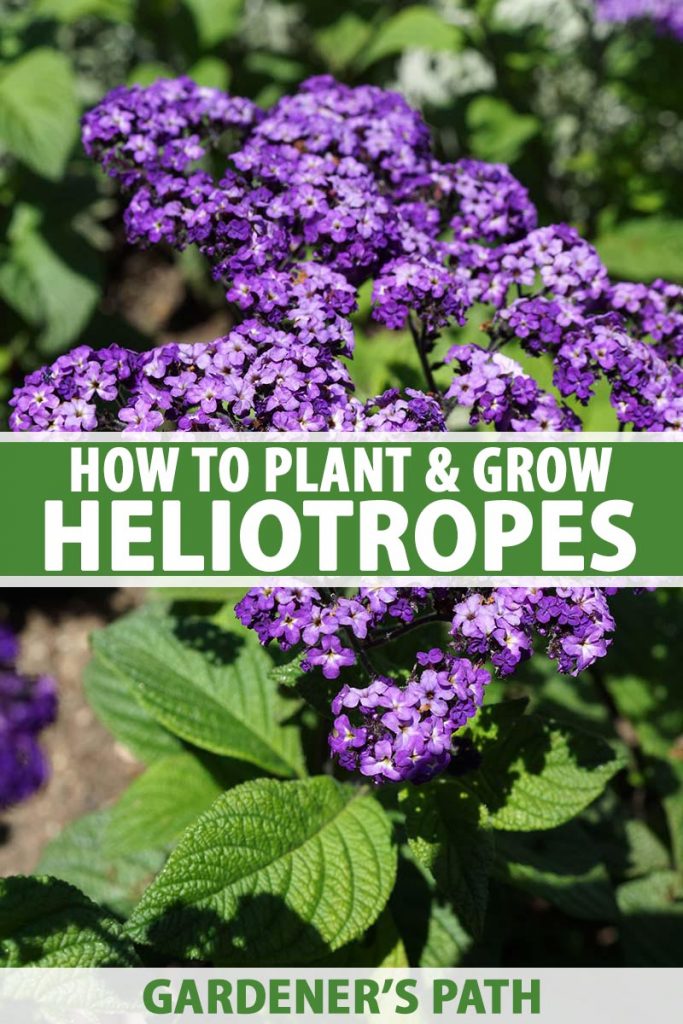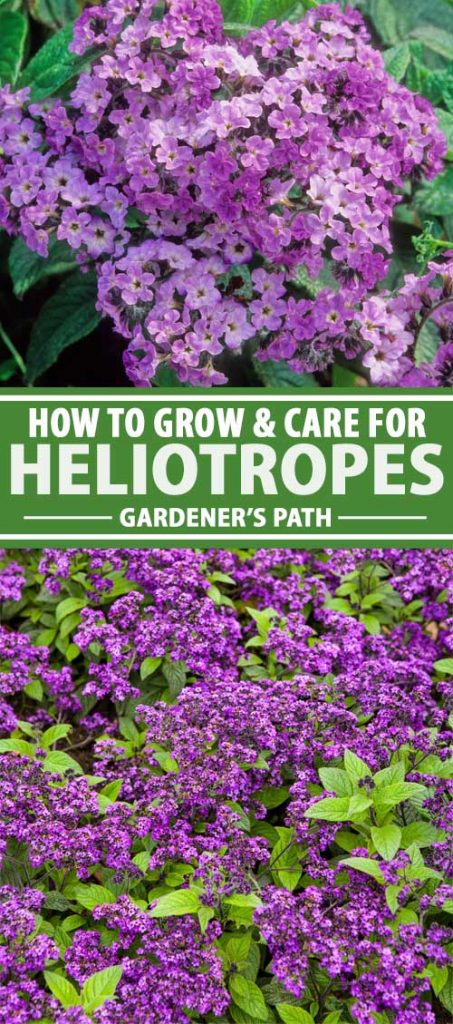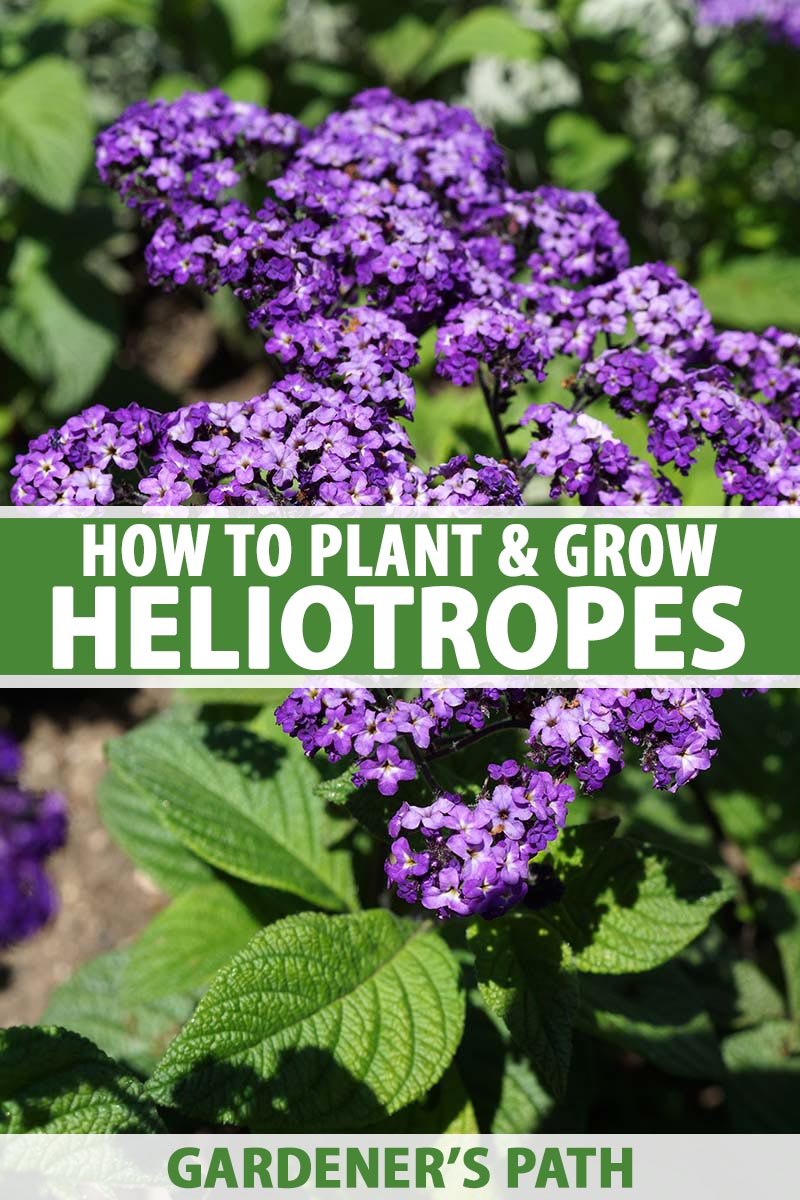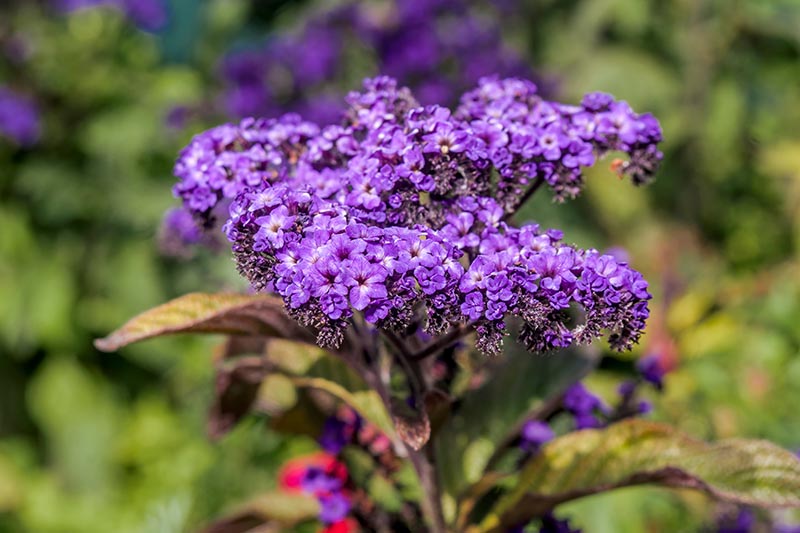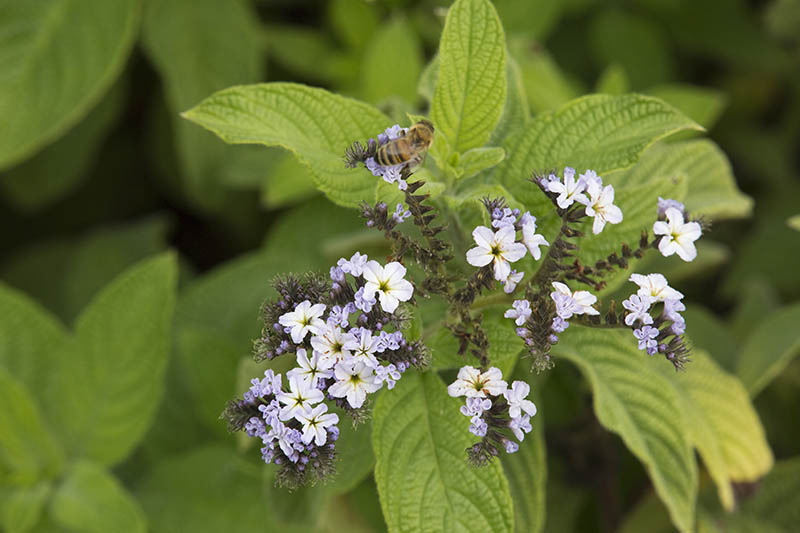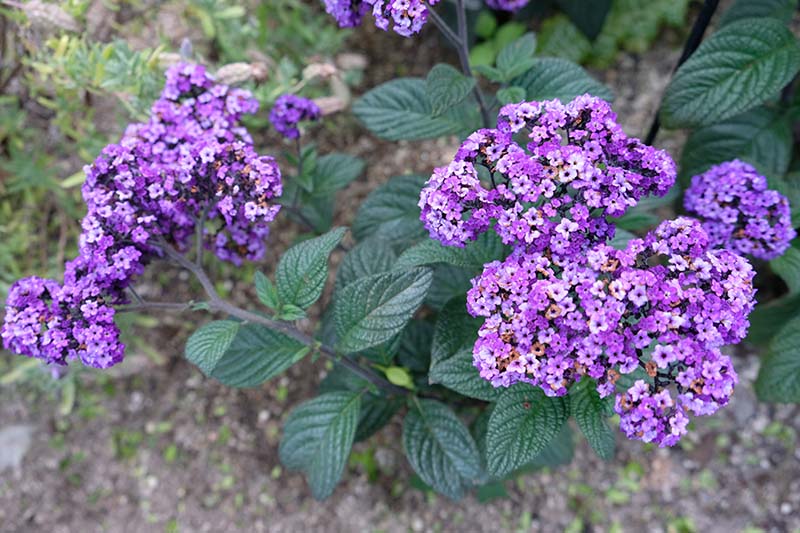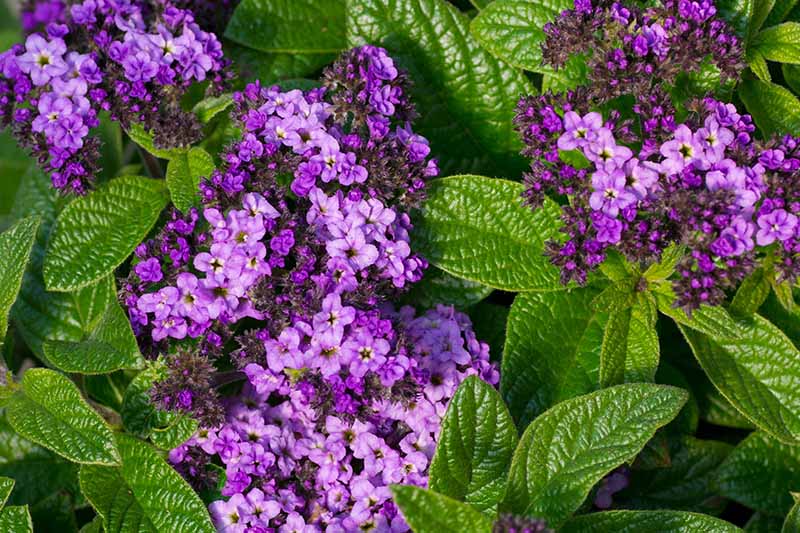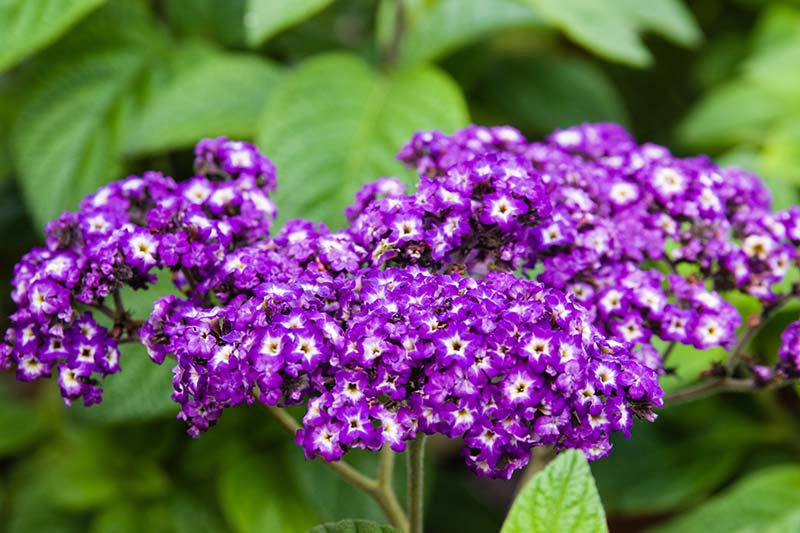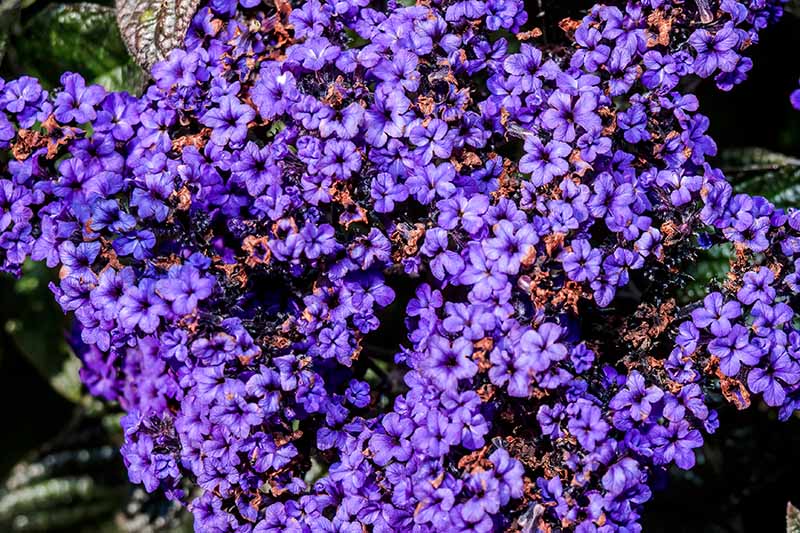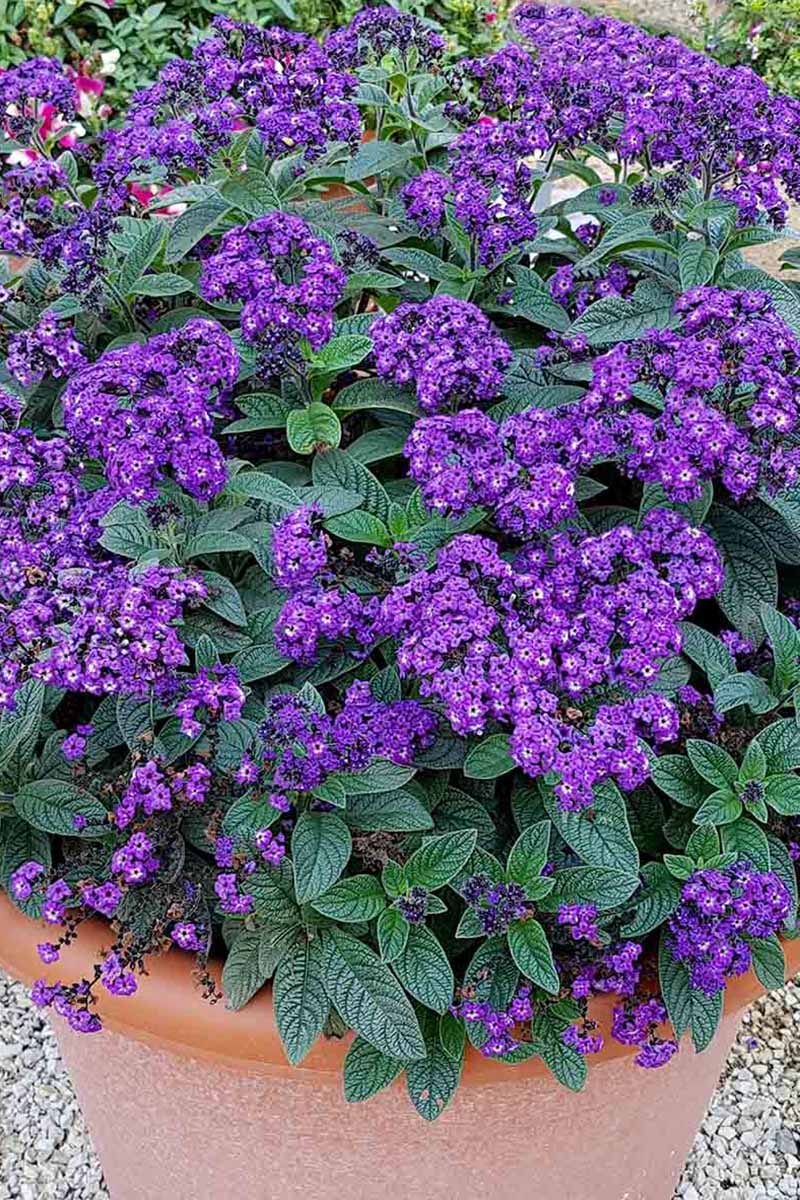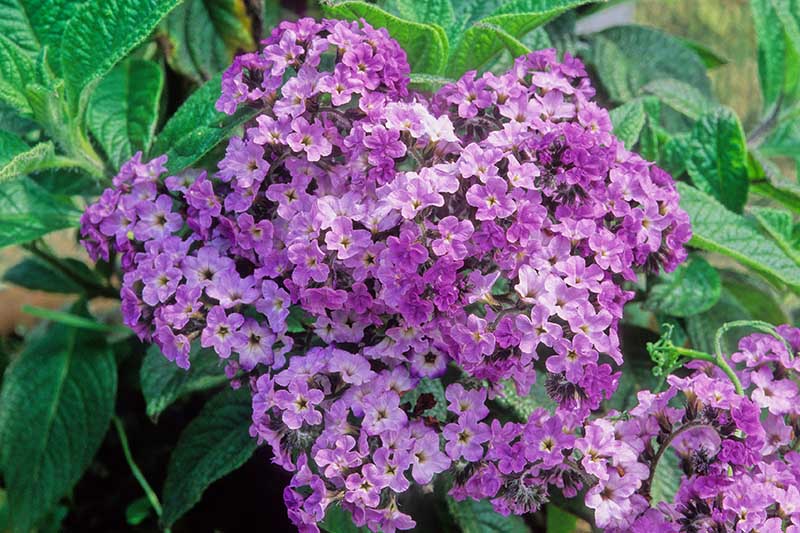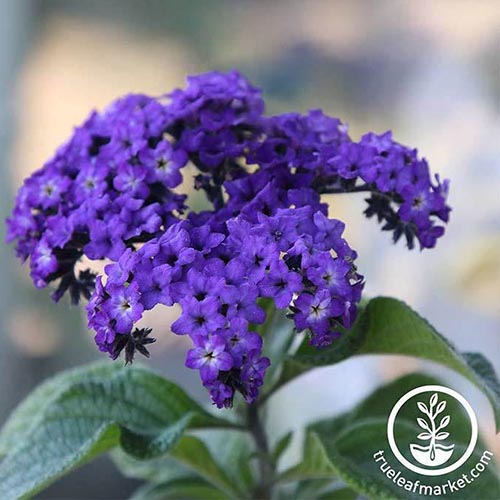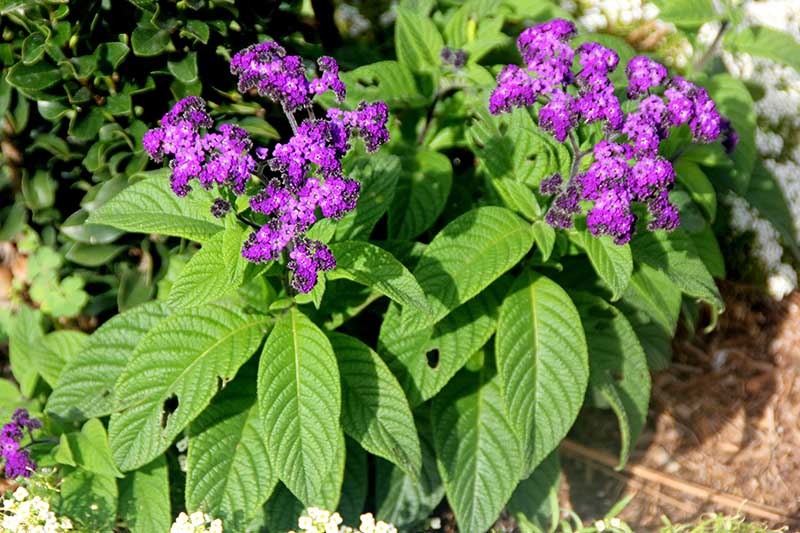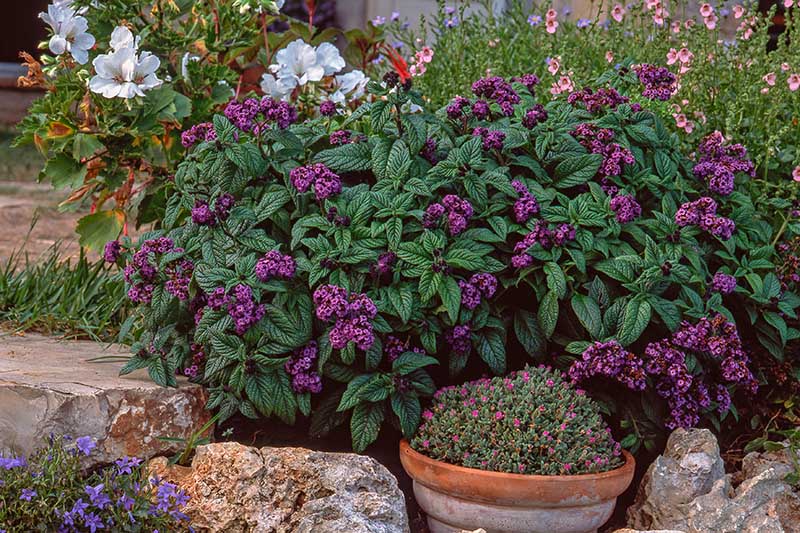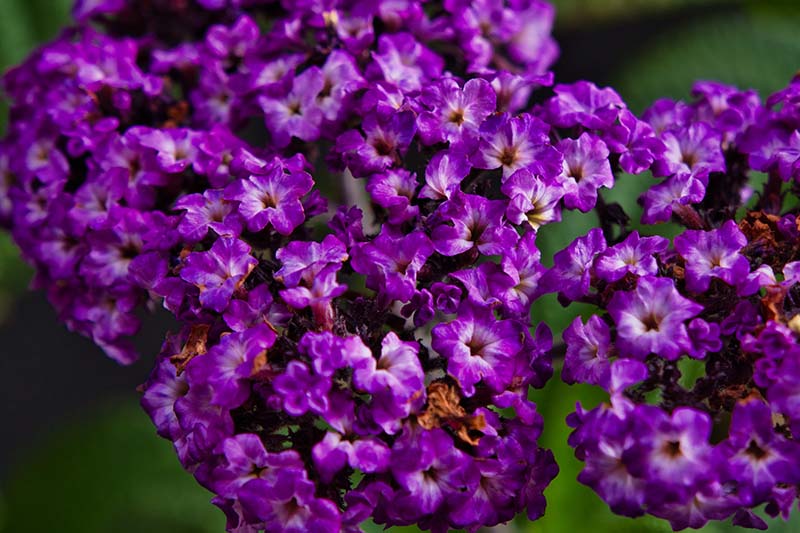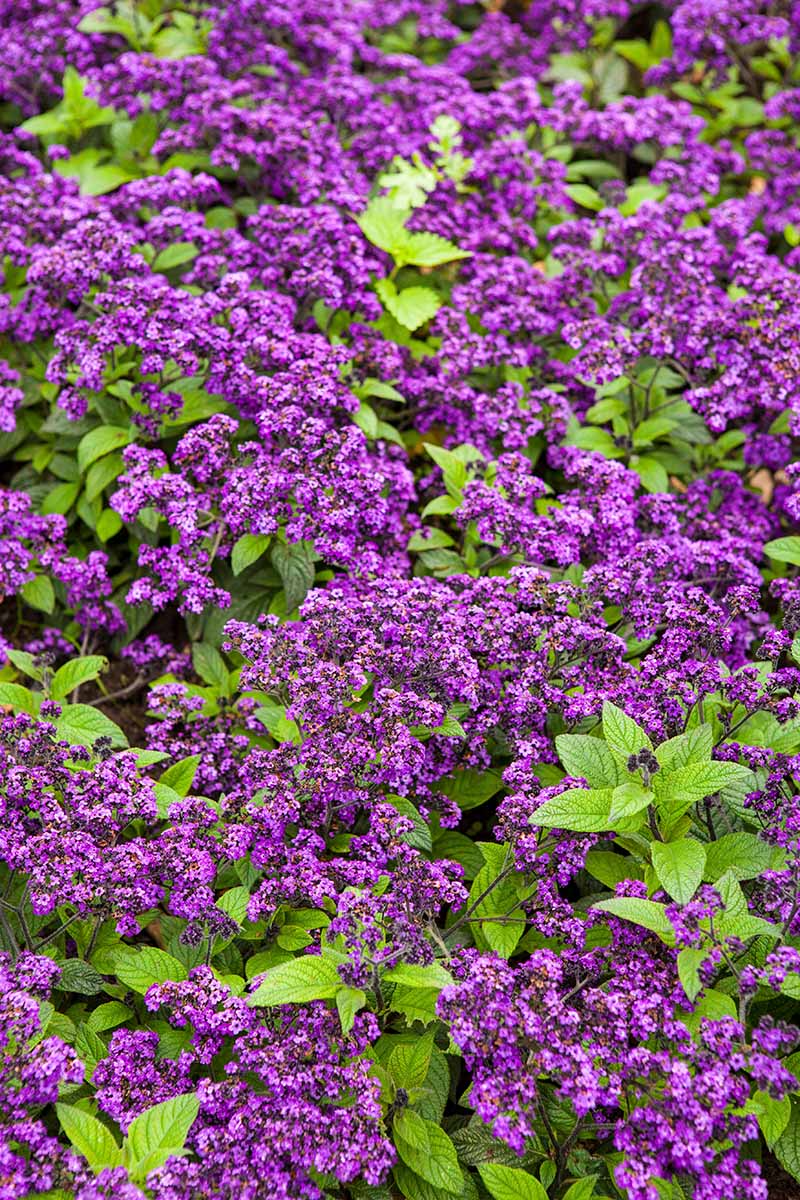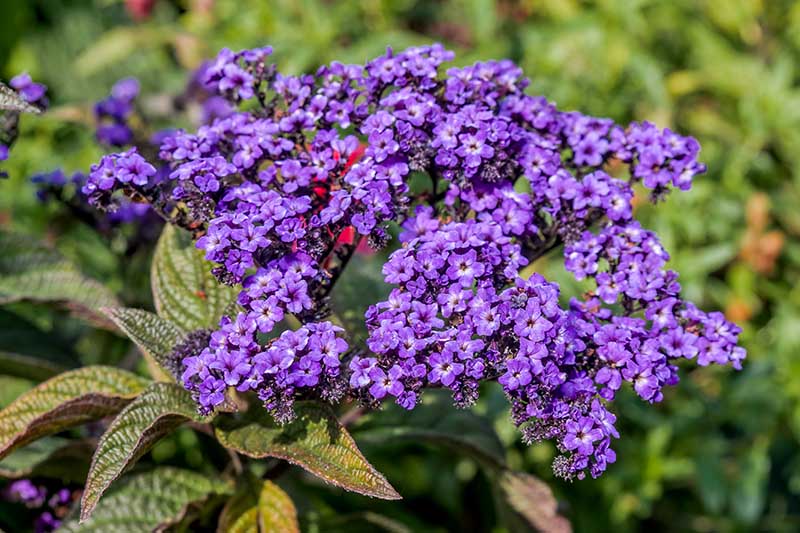With a backdrop of dark green pleated leaves, plants bear a resemblance to hydrangea or viburnum, and generally reach a mature height of between one and three feet tall. We link to vendors to help you find relevant products. If you buy from one of our links, we may earn a commission. Here’s what’s in store:
Cultivation and History
The Greek word “helios” means “sun,” and “tropos,” turn. Heliotrope’s name is derived from its habit of turning to face the sun, a characteristic which all “heliotropic” plants exhibit. The colors of the heliotrope blooms range from dark and light shades of purple to white. Its clustered five-lobe flowers resemble those of the forget-me-not.
Also called the common heliotrope and cherry pie plant, these humble names belie a beguiling fragrance that has been described as cherry-almond-vanilla. This plant has a temperate nature, meaning that it can’t withstand harsh weather extremes. It is best suited to gardeners in USDA Hardiness Zones 9 to 11. In my area of the northeast, it grows as a tender annual. This means that even a touch of frost spells disaster.
Elsewhere in the world, it is a tropical woody perennial. This is how it was growing when it was discovered in the 18th century in the Andes mountains of Peru, by French botanist Joseph de Jussieau, and brought to Europe. Soon its essence became the stuff of perfumes, and its beauty a backdrop for romance in lush cottage gardens.
Propagation
According to the Cornell University Heliotrope Growing Guide, you can start this plant from seeds or from stem cuttings.
This easy to grow plant thrives in the garden, as well as in both outdoor and indoor containers. Maturity takes between 84 and 121 days, so if you’re growing from seed, it’s best to get a head start indoors before planting out.
From Seed
Start seeds indoors 10 to 12 weeks before the last average frost date for your region. Sow 1/8-inch deep in seed starting trays with good quality potting soil and cover them lightly with soil. Germination can take between 28-40 days, during which time the soil needs to be kept at an even temperature of 70-75°F. You may need to use a heat mat. Maintain even moisture but do not allow the soil to become over-saturated. After germination, keep the seedlings indoors until the danger of frost has passed and the soil your garden has warmed to 60°F. As the seedlings mature, pinch back the growing tips to promote lateral, bushy growth. Seeds do not produce the most reliable results, nor the strongest plants. Hybrids do not produce seed that replicates the traits and quality of a parent plant.
From Cuttings
Towards summer’s end, you may cut stem tips from existing plants to root for next year. This is an excellent way to clone a favorite plant and give it a chance to grow strong before planting out the following spring.
Cut a five-inch section of a stem, just below a leaf node. Remove the leaves from the top half of the stem cutting, dip in powered rooting hormone and place in a small pot filled with a mixture of sand and perlite, or potting medium. Keep the rooting cuttings indoors, or in a greenhouse, and maintain even moisture. They should develop roots within two weeks. Once rooted, keep the soil moist but not waterlogged and they’ll be ready to plant out after the last spring frost date passes.
From Seedlings or Transplanting
Alternatively, you can find seedlings or nursery starts at your local garden center. They may be planted out when the danger of frost has passed, and the soil temperature is over 60°F. Dig a hole the same size as the container the transplant is growing in. Set the root ball in, and tamp down the soil before watering in well. All three methods yield plants that may be grown as annuals, tender perennials in the garden or containers, or indoors as houseplants.
How to Grow
The ideal conditions for growing heliotrope are a full sun location, and organically-rich, well-draining soil. The soil pH should be between 6.6 and 7.3. And while it loves to bask in the rays, in regions with intense summer heat, it not only tolerates a little light afternoon shade, it benefits from this protection.
One of the most important aspects of growing heliotrope is to keep the soil evenly moist, never letting it dry out completely, nor permitting it to get soggy and over saturated. This is especially challenging when growing in containers, as they dry out much quicker than ground soil. Be sure that your ground soil or potting medium drains well, as plants do not tolerate wet feet. Add sand to the soil as needed, and choose containers with holes in the bottom. As mentioned, you need to start heliotrope early, in order for it to have time to bloom during the growing season, and before the threat of autumn frost.
If you want to grow heliotrope as a houseplant, use a standard garden pot with a top rim diameter of 18 inches. Bring your plant indoors at summer’s end. Place it where it can receive daytime sunshine, and nighttime temperatures of 50°F to 55°F. If necessary, place the pot on a wheeled caddy, to make it easy to move around to meet these needs.
Both indoor and outdoor heliotropes are known as “heavy feeders,” and benefit from regular doses of flowering plant food throughout the growing season, according to the package instructions.
Growing Tips
This is a plant that likes lush surroundings where it can produce an abundance of rich blossoms that mesmerize with their enchanting fragrance. The following tips are sure to bring success:
Full sun is best, but a little afternoon shade is appreciated in the hottest regions. Keep the soil evenly moist, but be sure it drains well. Feed throughout the growing season for a profusion of blooms.
Pruning and Maintenance
While you are likely to find many descriptions that say this is a low-maintenance plant, in my opinion, it requires a bit of fussing to keep it happy and blooming profusely.
First, if you are growing it as an annual out of its comfort zone, you’ll have to start really early, or there won’t be time for it to bloom before the danger of frost rears its head in fall. In addition, a delicate balance is needed between keeping the soil moist at all times, but never soggy enough to cause the roots to rot. This is especially challenging with container plants, as pots dry out quicker than the ground. For bushier plants, you may pinch off a few inches off the growing tips of the stems. Do this as soon as your seedlings have their first flush of growth in spring, and before budding.
Fertilization throughout the growing season is required, which poses an additional challenge. Be sure to choose a well-balanced product, such as 10-10-10 (NPK) and consider diluting it to see how it affects your plants. Too much nitrogen may result in an excess of foliage at the expense of blooms. To keep plants bushy and attractive, prune leggy stems. When a cluster of flowers has finished blooming, remove the entire stem to retain shape, energize the plant, and encourage reblooming. If you are growing plants as annuals, you may bring them indoors as houseplants at season’s end. Find them a spot with sunny days, and nights between 50°F to 55°F, as mentioned above. Containers will likely need repotting every few years in the spring to refresh the potting medium. Spring is also the time to divide outdoor perennials as well as indoor houseplants, to rejuvenate them and make more plants. And finally, once plants die to the ground at season’s end, you can cut down the remains and apply a layer of mulch over the root area. This may prove especially beneficial if you are cultivating them on the cool fringe of their comfort zone.
Where to Buy
While botanical species heliotropes, as found in the wild, are purple, cultivars are available in various shades of blue and lavender, as well as white.
Marine
This popular cultivar bears clusters of deep violet blossoms atop ample green foliage, and thrives well in Zones 9 to 11. It is not only recommended that seeds be started indoors 10 to 12 weeks before the last spring frost, but that they be sprouted in total darkness.
‘Marine’ Well suited to borders and containers, this compact type reaches a petite 12 to 18 inches, and is appreciated for its resistance to mildew and disease. Find H. arborescens ‘Marine’ seeds now from True Leaf Market in packages of 100 or 1,000.
Managing Pests and Disease
Healthy heliotropes are unlikely to suffer from pests or disease. However, under less than ideal conditions, issues may arise. Pests to watch out for include:
Aphids Mealybugs Spider mites Whiteflies
They are more likely to be a concern with plants grown indoors, and when the soil is waterlogged. Usually all it takes to get rid of these pests is a spray from the hose. If that’s not enough, treat affected plants with neem oil or an insecticidal soap. While not prone to disease, sometimes the leaves may turn brown and begin to drop off. It may appear that the plant is thirsty, when in fact, the soil is actually too wet. Check the soil for excess moisture before assuming plants are too dry, or you may make the problem worse. Plants that are too wet are susceptible to fungal infection and rotting.
Best Uses
The fragrant, flouncy blossoms of heliotrope have many attractive garden applications. Add it to a collection of nectar-rich bloomers for a space that teems with butterflies, or give it an island of its own where its fragrance can multiply and captivate.
Edge a border garden for a swath of color along a winding walkway. Start a collection of hanging planters on the patio or make a window box display for up-close appreciation of heliotrope’s heavenly scent. There are so many possibilities! If you want to try your hand at horticultural art, learn how to train your plants like rose standards for a formal, tree-like appearance.
And finally, be sure to cut stems for vases, or bring entire plants indoors as houseplants, to enjoy them indoors, as well as out. Good companion plants with the same cultural requirements include African daisy, dahlia, hardy geranium, hydrangea, stock, and viburnum. Depending upon your zone, these plants may be annuals or perennials, or may grow best in containers, where they may be moved into protected areas as needed.
Quick Reference Growing Guide
Grandma’s Favorite in the 21st Century
You may remember heliotrope by its appearance, if not by name, from an elderly relative’s garden that you visited in your childhood. It’s so easy to mistake it for some type of hydrangea or viburnum, that you may only now be realizing that it was something entirely different. Today’s cultivars offer more shades of purple, as well as white, and bring old-world charm to the garden with their plush, velvety blossoms and beguiling fragrance.
Take out your garden planner and add this tender, shrubby perennial to your list, and start siting a location with full sun, and fertile soil that drains well. Buy one and fall in love. Then, try your hand at propagation, and make more of your new garden favorite! We love to hear from our readers. Have you planted heliotrope in your garden yet? Tell us in the comments below. And to learn more about growing flowers in your summer garden, you’ll need the following guides next:
How to Grow and Care for Dianthus Flowers How to Grow Garden Pinks for Old-Fashioned Charm How to Grow and Care for Hardy Hibiscus
© Ask the Experts, LLC. ALL RIGHTS RESERVED. See our TOS for more details. Originally published April 5, 2017. Last updated May 14, 2020. Product photo via True Leaf Market. Uncredited photos: Shutterstock.
